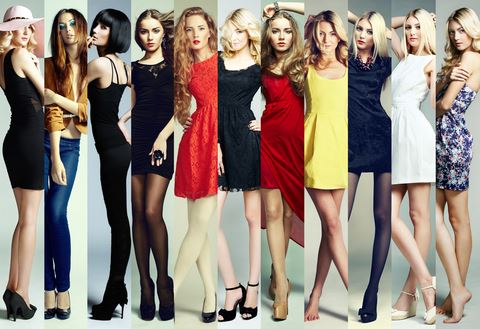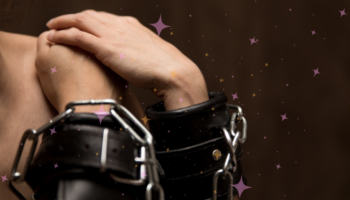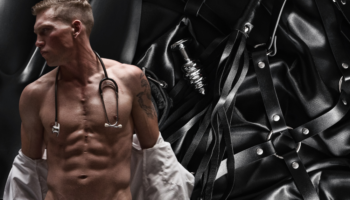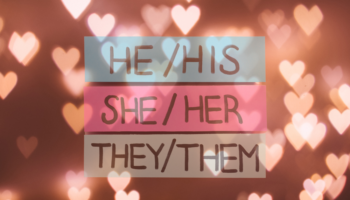Take a quick snapshot in your mind. Think about the ideal person that you’d love to explore intimacy with. Be it a long-term relationship or a quick, casual fling, take a second to think on and then remember the key physical and personality attributes of that hottie.
Have you ever done this before? Maybe while daydreaming on public transit, maybe while fantasizing during masturbation? Maybe even while having a good time with someone else? That person you imagined, their collection of outward and inward qualities, could be considered your ideal ... that person could also be considered your "type."
Is It Really YOUR Type?
The idea of a "type" is nothing new. People have declared their type for a long time. Some people like certain hair colors, physical builds, political philosophies - the list can be endless. Just like porn, if there is some aspect of a person to be enamored with, then someone else will list that attribute as their type.
The argument can be made that knowing, accepting and realizing your type is emotionally strong and valid. It is a self-actualization to understand that you want and, possibly, need certain characteristics in a partner. That feeling is wonderful - particularly when it is realized.
However, a person’s type is not always of their own creation. Media and social structures can play a significant role in determining which bodies are accepted and beautiful - which bodies are promoted as the ideal. It is no coincidence that that those bodies then become a prevalent type for many out there. Look through different cultural histories; ideal types were different at different times among different people.
Right now, our culture promotes a body type that is cis-gendered, white, fit, tall, "able," aalong with a personality that focuses on money and class. Because film, television and advertising promote these characteristics, people who do not fit that model are deemed undesirable to those who strive to meet that ideal person. How often do we see a slim, big-breasted, blonde-haired, white (but tanned) woman promoted as the paragon of desire? If there’s a male version, he’s pretty much the same - minus the breasts because that would challenge gender assumptions.
At the same time, it is important to recognize everyone’s individual choice of what they each find enchanting. It is entirely possible that those blonde bombshells are exactly what an informed, conscious person really, really wants.That autonomy of desire remains paramount even under a closer examination of the factors of that desire. Reconciling the difference between outside influences and legitimate personal feelings is a tricky differentiation. However, perhaps unpacking the idea of types will help to bridge the gap between the two.
Experts Weigh In on Using 'Types'
"I wouldn't use 'type’ language to describe my attractions," says Mitch Kellaway, journalist and assistant editor of Transgress Press. He finds the language of types "too limiting." This idea of classifying people, or "putting them in a box," can lead to problematic types of attraction. As Kellaway explains, once you determine that you are only attracted to a certain type of person, that phrasing is innately tied to dominating and internalized phobias. "When it comes from someone from the dominant identity (e.g. a cis person saying their type is other cis people), that's internalized cisgender privilege rearing its head; when it's a trans person saying 'I'm only attracted to cis people,' it's internalized transphobia. It's hard to face that we have internalized biases that were put there without our choice, but denying them doesn't change the reality."
At the same time, Venice of SexLifeandEverything.com sees these internal biases and suggests a need for understanding. "I can't argue with a man and 'make him turn to bisexual Asian women’ when that's not what he wants," she argues. "I can't make the man who prefers a 200-pound redhead, a.k.a. his type, fall in love with me. I won't make a PowerPoint presentation stating all the reasons why I'm just as good as her because it's irrelevant." Allowing people to explore and discover what truly turns them on is a hallmark of progressive sexual thinking. If you think of it that way, should body and character preferences be any different than accepting that people have a need for BDSM, kink, vanilla sex or other fetishes and paraphilias?
Performance artist and community organizer Alok Vaid-Menon suggests a need to move the idea of desirability away from "the neoliberal tropes of individual culpability and moral responsibility." They feel that deeming individual desire as "wrong" shifts the conversation to prejudice and attitude instead of the true systemic issues. "I don't actually think that we're going to end white supremacy by having individual white people sleep with people of color. For sure challenging our desires to expand the horizon of our possibilities is important work. But it shouldn't be the only work or take all of our energy."
Instead, Alok argues, breaking down the systems that ensure the power of specified, targeted attraction will go further in maintaining personal choice in the face of societal pressures. "Because the truth is that many of us don't have prejudiced desires because we want to, but because we have been socialized in a society that has made us." (Loving your OWN body matters too. Check out 6 Steps that'll Help You Love, Love, Love Your Naked Self.)
Can We Move Away From Societal Types?
Can we move away from those influences? Can we demand change in the bodies represented as ideal types? Slowly, very slowly, a wider variety of people are being showcased across media and social structures. The Internet has a lot to do with this as different depictions of desirable people are readily available for consumption - if you look for them. A better goal is to ensure this wider variety is offered throughout our systems.
So, think back to that person you imagined at the beginning. Has the image changed?
Jon Pressick is a sex-related media gadabout. For more than 20 years, Jon has been putting sex into our daily conversations at his long-running site SexInWords—as a writer, editor, publisher, sex toy reviewer, radio host, workshop facilitator, event producer and more. These days, he focuses on writing for Kinkly, GetMeGiddy, The Buzz and PinkPlayMags and editing Jason Armstrong's series of Solosexual books. In 2015, Jon edited Cleis Press' Best Sex Writing of the Year, V1 to rave reviews. He's also the winner of the 2010 TNT Favourite Adult Journalist Award and one of Broken Pencil's 50 People and Places We Love past co-host and producer of Sex City. Jon co-produced the queer literary festival Writing Outside the Margins with Xtra Magazine for two years. You can find him on Twitter at @Sexinwords.




